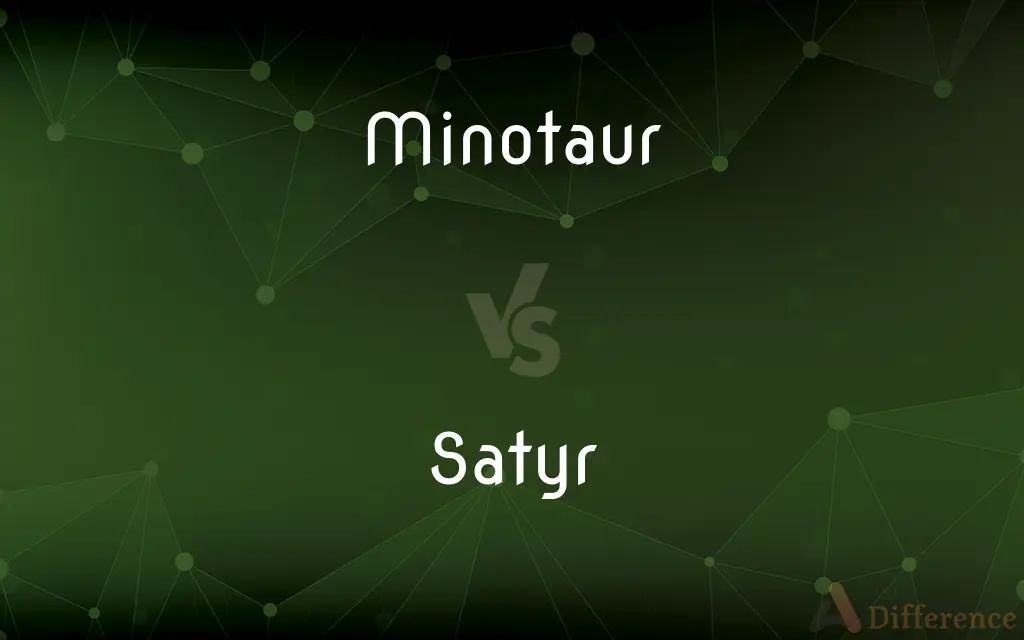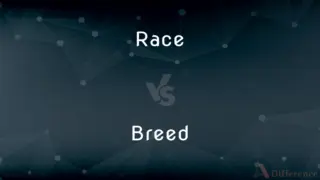Minotaur vs. Satyr — What's the Difference?
By Fiza Rafique & Urooj Arif — Updated on April 23, 2024
Minotaur is a mythical creature with the head of a bull and the body of a man, associated with mazes and strength, while Satyrs are half-human, half-goat beings, linked to music and revelry.

Difference Between Minotaur and Satyr
Table of Contents
ADVERTISEMENT
Key Differences
The Minotaur is a creature from Greek mythology, famously known for its unique combination of a bull's head on a human's body, symbolizing ferocity and confinement within the Labyrinth of Crete. In contrast, Satyrs, also from Greek mythology, are depicted as half-man, half-goat with attributes leaning towards mischief, music, and merrymaking, highlighting their role in the retinue of Dionysus.
Minotaurs are primarily noted for their role in the myth of Theseus and the Labyrinth, a story that emphasizes themes of heroism, sacrifice, and the struggle against monstrous forces. On the other hand, Satyrs are often portrayed in myths as followers of Dionysus, indulging in the wild festivities, which underscores their association with freedom and excess.
The Minotaur's depiction in art and literature often evokes a sense of dread and danger, used as a metaphor for an unstoppable beast or an insurmountable challenge. Whereas Satyrs are typically shown in a lighter, more comical light, reflecting their lustful and hedonistic nature, often causing and resolving comedic dilemmas.
In terms of cultural significance, the Minotaur represents a powerful obstacle to be overcome, a beast lurking at the heart of a complex maze. Satyrs, however, symbolize the unrestrained natural instincts and the pleasures of the senses, often serving as a reminder of the human connection to nature and our primal desires.
Minotaurs and Satyrs both serve as popular subjects in modern fantasy genres, though they inspire different aspects of storytelling. The Minotaur often appears as a formidable antagonist or a guardian of treasures, while Satyrs are used more for side characters, providing comic relief or sage advice through a playful demeanor.
ADVERTISEMENT
Comparison Chart
Origin
Greek mythology, creature of the Labyrinth
Greek mythology, associated with Dionysus
Appearance
Bull's head, human's body
Half-human, half-goat
Symbolism
Confinement, danger
Freedom, revelry
Cultural Role
Obstacle, antagonist
Comic relief, advisor
Typical Depiction
Fierce, monstrous
Playful, mischievous
Compare with Definitions
Minotaur
Symbol of entrapment and challenge in mythology.
Facing a problem like a Minotaur, he felt both terrified and invigorated.
Satyr
Often portrayed with musical instruments, symbolizing their love for music.
With a flute in hand, he was as joyful as a Satyr in spring.
Minotaur
Often depicted as a guardian of secrets or treasures.
Like a Minotaur, he guarded his secrets fiercely from the world.
Satyr
Epitome of earthy and animalistic desires.
His unchecked desires reminded her of a Satyr's pursuit of joy.
Minotaur
Represents monstrous and insurmountable obstacles.
His personal demons were like a Minotaur, daunting and relentless.
Satyr
Commonly appears in comedic roles in ancient plays.
His antics on stage brought to mind a Satyr's playful tricks.
Minotaur
Mythical beast with a bull’s head and man’s body, known for its strength.
The Minotaur roared fiercely in the confines of the labyrinth.
Satyr
Half-man, half-goat creature of Greek mythology, emblematic of pleasure and chaos.
The party was wild, filled with laughter and dances like those of a Satyr.
Minotaur
Central figure in the myth of Theseus.
The Minotaur awaited the arrival of its next challenger, as foretold in legends.
Satyr
Frequent character in tales of Dionysus, representing excess and festivity.
Acting like a Satyr, he led the revelry into the night.
Minotaur
In Greek mythology, the Minotaur ( MY-nə-TOR, MIN-ə-TOR, US: MIN-ə-TAR, -oh-; Ancient Greek: Μινώταυρος [miːnɔ̌ːtau̯ros]; in Latin as Minotaurus [miːnoːˈtau̯rʊs]) is a mythical creature portrayed in Classical times with the head and tail of a bull and the body of a man or, as described by Roman poet Ovid, a being "part man and part bull". He dwelt at the center of the Labyrinth, which was an elaborate maze-like construction designed by the architect Daedalus and his son Icarus, on the command of King Minos of Crete.
Satyr
In Greek mythology, a satyr (Greek: σάτυρος, translit. sátyros, pronounced [sátyros]), also known as a silenus or silenos (Greek: σειληνός seilēnós [seːlɛːnós]), is a male nature spirit with ears and a tail resembling those of a horse, as well as a permanent, exaggerated erection.
Minotaur
(Greek mythology) Minotaur
Satyr
Often Satyr Greek Mythology A woodland creature depicted as having the pointed ears, legs, and short horns of a goat and a fondness for unrestrained revelry.
Minotaur
Anything resembling the Greek monster, whether by appearance or by strength.
Satyr
A licentious man; a lecher.
Minotaur
A fabled monster, half man and half bull, confined in the labyrinth constructed by Dædalus in Crete.
Satyr
A man who is affected by satyriasis. No longer in clinical usage.
Minotaur
(Greek mythology) a mythical monster with the head of a bull and the body of a man; slain by Theseus
Satyr
Any of various satyrid butterflies having brownish wings marked with eyespots.
Satyr
(Greek mythology) A sylvan deity or demigod, male companion of Pan or Dionysus, represented as part man and part goat, and characterized by riotous merriment and lasciviousness, sometimes pictured with a perpetual erection.
Satyr
(Roman mythology) faun
Satyr
(by extension) A lecherous man.
Satyr
Any of various butterflies of the nymphalid subfamily Satyrinae, having brown wings marked with eyelike spots; a meadow brown.
Satyr
(obsolete) The orangutan.
Satyr
A sylvan deity or demigod, represented as part man and part goat, and characterized by riotous merriment and lasciviousness.
Rough Satyrs danced; and Fauns, with cloven heel,From the glad sound would not be absent long.
Satyr
Any one of many species of butterflies belonging to the family Nymphalidæ. Their colors are commonly brown and gray, often with ocelli on the wings. Called also meadow browns.
Satyr
The orang-outang.
Satyr
One of a class of woodland deities; attendant on Bacchus; identified with Roman fauns
Common Curiosities
Where does the story of the Minotaur originate?
The story of the Minotaur originates from Greek mythology, specifically from the legends surrounding King Minos of Crete.
What role does the Minotaur play in Greek mythology?
In Greek mythology, the Minotaur is a fearsome creature that resides at the center of the Labyrinth, designed by Daedalus, and serves as an antagonist in the myth of Theseus.
How are Satyrs typically portrayed in mythology?
Satyrs are portrayed as mischievous and lascivious creatures, companions of Dionysus, often engaged in drunken revelry and playing music.
What are the typical characteristics of Satyrs in art?
In art, Satyrs are typically depicted with goat-like features such as horns, tails, and hooves, with an unruly appearance and often holding a musical instrument.
What is the significance of the Labyrinth in the Minotaur’s story?
The Labyrinth in the Minotaur's story symbolizes a complex and confusing structure, designed to contain the beast, reflecting themes of entrapment and confusion.
How do Minotaurs compare to other mythological creatures?
Minotaurs are unique in their half-bull, half-human form, making them distinctly fearsome and symbolic of physical strength and confinement, unlike many other creatures who may represent speed, wisdom, or other attributes.
What is the typical setting for Satyr stories in mythology?
Satyr stories in mythology are typically set in natural, wild landscapes like forests and mountains, reflecting their connection to the untamed aspects of nature.
Do Satyrs have any special powers in myths?
Satyrs are not typically depicted with special powers, but their association with Dionysus and nature imbues them with a supernatural ability to incite and partake in wild festivities.
How is the Minotaur typically defeated in stories?
The Minotaur is typically defeated by Theseus in Greek mythology, who navigates the Labyrinth with the help of Ariadne’s thread and kills the Minotaur, symbolizing the triumph of civilization over chaos.
What impact have Satyrs had on literary works?
Satyrs have influenced literary works by embodying the themes of natural instinct versus civilized behavior, often appearing in works that explore themes of freedom, excess, and the human condition.
Are there female Satyrs in mythology?
Female counterparts to Satyrs are known as Maenads or Bacchae, though they are typically human women followers of Dionysus known for their frenzied state and not half-goat like Satyrs.
How is the Minotaur viewed in modern culture?
In modern culture, the Minotaur often appears in literature and media as a symbol of personal and psychological battles, representing internal or societal conflicts.
Can Minotaurs communicate with humans in myths?
In myths, Minotaurs do not typically communicate with humans; they are usually portrayed as monstrous and primal forces rather than beings capable of speech or reason.
What role do Satyrs play in Dionysian rites?
In Dionysian rites, Satyrs play a central role as embodiments of the wild, unrestrained nature of the festivities, engaging in dance, music, and the overall debauchery that characterizes these rites.
How do depictions of Satyrs differ across cultures?
While originally a part of Greek mythology, depictions of Satyrs have been adapted in Roman culture as more hedonistic and less human, often blending with their own faunus figures, emphasizing their nature-bound and lustful characteristics.
Are there any famous artworks featuring the Minotaur?
Yes, the Minotaur has been a subject in many famous artworks, including Picasso’s “Minotauromachy,” which portrays the creature in a complex scene of struggle and symbolism.
Share Your Discovery

Previous Comparison
Correct vs. Correctly
Next Comparison
Race vs. BreedAuthor Spotlight
Written by
Fiza RafiqueFiza Rafique is a skilled content writer at AskDifference.com, where she meticulously refines and enhances written pieces. Drawing from her vast editorial expertise, Fiza ensures clarity, accuracy, and precision in every article. Passionate about language, she continually seeks to elevate the quality of content for readers worldwide.
Co-written by
Urooj ArifUrooj is a skilled content writer at Ask Difference, known for her exceptional ability to simplify complex topics into engaging and informative content. With a passion for research and a flair for clear, concise writing, she consistently delivers articles that resonate with our diverse audience.













































